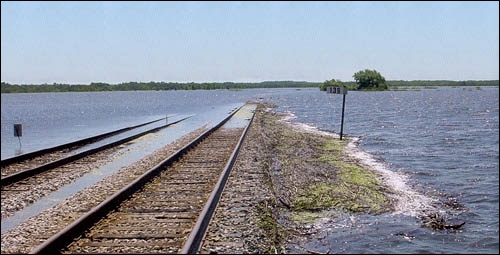 |
Fall 2008
|
Innovation and Hard Work Ensure Safe Operations During US Midwest
Flooding

 The Watertown Subdivision
lived up to its name during the month of June. the line was closed on 9 Jun 2008 when heavy rains
overflowed the banks of the Crawfish River near Reeseville, Wisconsin. The flooding submerged approximately 1.2
miles of track in Reeseville marsh, cresting about four feet above the rail by 16 Jun 2008. During that
time, 165 trains were rerouted over secondary lines and on other railroads to provide continuous service to our
customers. The Watertown Subdivision
lived up to its name during the month of June. the line was closed on 9 Jun 2008 when heavy rains
overflowed the banks of the Crawfish River near Reeseville, Wisconsin. The flooding submerged approximately 1.2
miles of track in Reeseville marsh, cresting about four feet above the rail by 16 Jun 2008. During that
time, 165 trains were rerouted over secondary lines and on other railroads to provide continuous service to our
customers.
 Representatives from several operations departments were on site to determine how and when the line could be
re-opened safely. "Among our personnel were service area managers Steve Cork for field ops and
Jim Johnson for mechanical, as well as track maintenance manager Jon Bursheim, track maintenance supervisor, Steve
Baures, and divisional track inspector Eddie Lewandowski", said Glyn Hughes, service area manager for
engineering. Glyn also enlisted the assistance of our geotechnical engineering department to ensure that when
operations resumed the track bed would be stable.
Representatives from several operations departments were on site to determine how and when the line could be
re-opened safely. "Among our personnel were service area managers Steve Cork for field ops and
Jim Johnson for mechanical, as well as track maintenance manager Jon Bursheim, track maintenance supervisor, Steve
Baures, and divisional track inspector Eddie Lewandowski", said Glyn Hughes, service area manager for
engineering. Glyn also enlisted the assistance of our geotechnical engineering department to ensure that when
operations resumed the track bed would be stable.
"The group inspected the track while it was under water to see if it would be save to push and pull our traffic
across the flooded area, safely and without damage to our track-bed", said Chris Bunce, manager of
geotechnical engineering. "We also assessed and predicted the depth and duration of the flood water over the
track".
The assessments were critical in preparation for the first push/pull train operations, and ultimately the return to
normal operations.
"Our geotechnical team is now working together with Curt Whelan of the project service group and Danny Wong,
manager of structures for the Chicago Service Area, to engineer a solution that will protect our operations during
floods in the future", Chris said. "These efforts include developing a potential means of safely raising
our entire track structure by as much as four feet, for a distance of a mile or more, with minimal impact on train
service".
"We want to minimize the environmental impact of such occurrences, particularly in sensitive wetlands".
While the line was out of service, traffic was rerouted over the Iowa, Chicago & Eastern ( IC&E ), the
Wisconsin & Southern ( WSOR ), BNSF, UP, and CN. "We also had the cooperation of CSXT and NS to get our
traffic between Detroit and Chicago, then through to the Southern Ontario and Montreal service areas", said
Mike Romano, director of operations for the NMC - Central.
The line was reopened for push/pull operations Sunday, 29 Jun 2008, when the water had receded to
within six inches of the railhead. Track speed was restricted to three mph. Train 199-24 was the first
through the water. For nearly three weeks, the on site team managed the situation without incident. Normal
operation, at 10 mph, resumed on the morning of 30 Jun 2008.
Both the DM&E and IC&E also survived a period of serious floods in 2008 that temporarily disrupted service.
But much like there counterparts in Soo territory, employees there came together to restore operations and protect
the service to our customers.
Difficult operating conditions always bring out the best in railroaders, and these recent examples were no
exception.
This Momentum article is copyright
2008 by the Canadian Pacific Railway and is reprinted here with
their permission. All photographs, logos, and trademarks are the property of the Canadian Pacific Railway
Company.
|